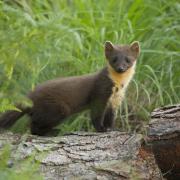Across the world, amphibians are declining faster than any other class of animal on the planet, primarily down to habitat loss and increasing pesticide use and water pollution.
One of those most dramatically affected is the great crested newt. Despite having survived on the planet for 40 million years, today it’s an internationally endangered species, protected by law.
Hope lies in the bucolic 150 hectares around Earth Trust Centre. At the foot of the iconic hills of the Wittenham Clumps in South Oxfordshire, it has become home to one of the largest and most significant populations of great crested newts anywhere in the UK, making it one of Europe’s most important sites for wildlife.

The rarest of the rare
Earth Trust is an environmental charity with 40 years’ experience in caring for and inspiring others with green spaces, with some 500 hectares of farmland, wildflower meadows, wetlands and woodland around the county, full of nature and heritage. And it’s one of these woods that holds the key to supporting the precious newt population.
The UK has three native species of newt – smooth newts, palmate newts – and the largest, and rarest of the trio – the great crested newt.
The surrounding grassland and treescape of Little Wittenham Wood have proved to be a safe haven for the species, and the area is designated not only as a Site of Special Scientific Interest (SSSI) but also a Special Area of Conservation.

Great crested newts can be found across many of Earth Trust’s green space sites, but the wood is home to the largest population. Key to the success is a series of ponds that run through the middle of the woods, providing a sheltered habitat for a range of amphibians who breed in the ponds every year, from frogs and toads, to smooth newts and their great crested newt cousins.
Growing up to 17cm in length – smooth newts and palmate newts are half their size – great crested newts can live up to 15 years in the right environment. Dark brown or black in colour, with a distinct ‘warty’ skin, each one has a unique pattern of black spots on their orange underbelly, much like a human fingerprint.

Water-loving land dwellers
Although we think of newts as living in ponds, they spend most of the year on terra firma. In summer and autumn, they’re to be found in hedgerows and boggy grassland, where they hunt for invertebrates. They wait out the winter months in a hibernaculum; a muddy bank, compost heap or amongst tree roots. And then in spring, they venture back to the water to find the perfect pond for breeding (so this is the perfect month to spot the unique creatures).
All of which requires a varied set of habitats that support the amphibians’ differing needs for food, shelter and breeding through the course of the year.
Earth Trust ranger, Charley Scales explains more. ‘We actively manage our woodlands for the benefit of both people and wildlife, to make sure both can thrive, in harmony.

‘We work the woods in a way that encourages predominantly broad leaved trees, with some conifers for variety. This includes coppicing, cutting species such as hazel and spindle to their base in the winter to create open sunny glades within the wood which provides perfect habitats for invertebrates, small mammals and woodland birds.
‘It’s a traditional technique that helps create a diverse structure to the woodland and generates piles of stacked brash, ideal for newts to hibernate in, as well as producing materials we can use to build and repair hedgerows, another important wildlife habitat.
‘To keep amphibians safe and undisturbed, we stack any timber that is due to be removed on ‘bearers’ which keep it off the ground to discourage newts from hibernating there. When this isn’t possible, we remove the timber in late spring, once the weather is warmer and the newts are back in the ponds.’

Dressed to impress
It’s only in spring that the males develop the jagged crest along their back that gives them their name, along with a white ‘flash’ on their tail, to impress females. Standing on their front legs with their back arched, they wave their tails to waft pheromones and secure their mate.
Female newts lay one egg at a time on a carefully selected piece of pond plant. They will ‘sniff’ the leaf to make sure it has the right cellulose levels and then lay an egg, close the leaf around it with their back legs, and ‘glue’ it shut to cocoon the egg.
Great crested newts are very particular in their requirements and will travel up to 1km to find the right pond, so their presence in Little Wittenham Wood is a great indicator of a healthy, clean water source.
Clearly the conditions in this corner of the Chilterns are just right for the great crested newt population, and in 2022, as part of a new wetland creation project alongside the Thames, the charity created three new ponds in Little Wittenham Woods, to provide more space for newts and other pond life.

Time to save the dinosaurs
Over recent years there has been an ever-increasing acknowledgement that leaving areas in our gardens a little wilder, and creating water features, no matter how small, can provide amphibians with much-needed resources.
Ponds are vital habitats for all kinds of species, and they’re one of the best things you can do in your garden to dramatically increase your support for wildlife.
We can all play a part in helping these miniature dinosaurs survive. Let’s get digging!
Facts & stats
Avaricious appetites: Great crested newt tadpoles will feed on just about anything, including insect larvae, frogspawn and tadpoles. As adults, they are even more voracious and will eat juvenile smooth newts, worms and beetles.
Predators beware: Toxins in the skin secretions of the newt act as a defence mechanism against larger predators, like foxes, badgers and birds.
Rejuvenating DNA: Newts have the ability to regenerate their limbs, eyes, spinal cords, hearts, intestines, and upper and lower jaws.
Earth Trust, Little Wittenham, Oxfordshire, OX14 4QZ, earthtrust.org.uk



























